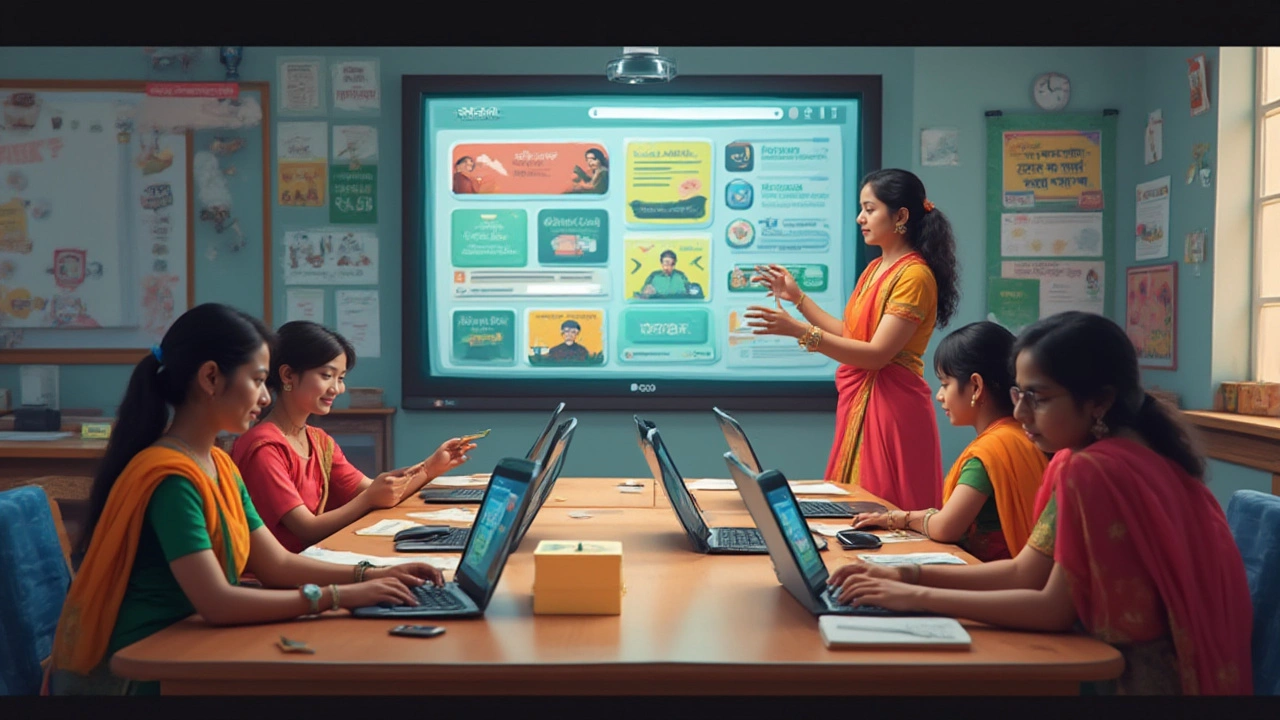5 Jul
2025
What is an eLearning Platform? Guide to Online Learning Platforms in 2025

Picture this: your classroom is no longer a stuffy room with flickering lights, but a place that spans every continent on the globe—without you having to leave your bedroom. This isn’t sci-fi, this is eLearning in 2025. While streaming TV is now the norm, so is streaming your college algebra class or learning a new language at midnight. The wild part? Over 200 million people enroll in online courses each year, according to Class Central. And the line between physical and digital education is thinner than ever. So, what actually is an eLearning platform?
The Nuts and Bolts: What Makes an eLearning Platform?
We throw the word “platform” around all the time, but at its core, an eLearning platform is a digital space where teachers and learners connect. Think of it like an app, but built for education. The course content, lectures, assignments, and often even the tests all live inside this virtual hub. Unlike searching for random YouTube tutorials, a strong platform gives you structure, tracks your progress, and keeps everyone organized—even if you’re a chronic procrastinator.
Let’s break it down. Most eLearning platforms roll in a Learning Management System (LMS), so instructors can upload lessons, grade assignments, and chat with students. Students can attend live lectures (Zoom-style), rewatch video lessons, submit homework, and get feedback all in one place. Platforms like Moodle, Canvas, and Blackboard have been giants in the education world for years, while Udemy, Coursera, and Khan Academy opened the gates for millions of self-learners. Some are open to anyone, others need an invite from a school or company.
One thing everyone forgets: eLearning platforms are about community, too. Discussion boards, study groups, and even virtual coffee breaks all happen inside these spaces. Last year, a LinkedIn survey found that over 40% of online students said they made new friendships through group forums and class projects. That’s more than the number who swapped phone numbers in their college lectures a decade ago!
Most modern platforms now include AI-powered tutors, gamified quizzes, and instant feedback systems. And in 2025, there’s a heavy focus on accessibility—think screen readers, subtitles in dozens of languages, and video chat tools for the deaf and hard of hearing. This makes the technology way more inclusive than most physical campuses ever managed to be. Got a smartphone or a laptop? You’re in.
Types of eLearning Platforms: One Size Does Not Fit All
Believe it or not, not all eLearning platforms are built the same. There’s actually a buffet of options—each matching different styles, goals, and budgets. Here’s a breakdown:
- LMS (Learning Management Systems): These are usually for universities and companies. Think Canvas, Blackboard, or Moodle. They handle courses, schedules, grades, and even discussion boards in one controlled spot.
- MOOC (Massive Open Online Course) Platforms: These giants—including Coursera, edX, and FutureLearn—let you join in on university-style courses from top institutions. Anyone can sign up, free or for a small fee. Certificates? Yes. Peer chat? Yes. Ivy League content? Sometimes, for much less money.
- Video-Based Learning Platforms: Think MasterClass or YouTube Learning. Turns lectures into binge-worthy streaming content. Super popular for how-to lessons, languages, cooking, and arts.
- Corporate Training Platforms: Companies like LinkedIn Learning, Pluralsight, or SAP Litmos help businesses train employees with career-relevant courses.
- Specialty Platforms: Platforms like Duolingo (languages), SoloLearn (coding), or Skillshare (creative skills) focus on a niche and use creative methods, like games or projects, to teach.
Don’t think they’re all just for students; a ton of teachers use them to earn side income or launch full-time careers as online educators. In some countries, this is now the main option for learning after grade school. India’s BYJU’S, for example, reached over 150 million users by 2024—proof that digital learning isn’t just a Western phenomenon.
The real kicker is hybrid models—blending face-to-face classes with digital tools. About 68% of universities in North America now use hybrid approaches, according to Educause, mixing classroom discussion with at-home modules. This hybrid setup is what students say helps with both flexibility and motivation.

Key Features Everyone Looks For
So, what separates a pain-in-the-neck platform from one you’ll actually use? It boils down to a few must-have features.
- User-Friendly Interface: If it feels like using a 1997 website, people bounce. Clear layouts and intuitive navigation are essentials.
- Mobile Access: Nearly 65% of users access lessons on their phones, so apps (with offline options) make or break the experience.
- Interactive Tools: Quizzes, flashcards, and instant poll features keep courses fun and break up the monotony of just reading text.
- Community Spaces: Built-in group chats, discussion, and peer review help students feel less isolated and more engaged.
- Customization: Letting both teachers and students adjust how content is delivered—like video vs. reading or self-paced vs. scheduled—makes a platform fit more learning styles.
- Security and Privacy: Nobody wants their grades or identities floating around the web. Secure login systems, encryption, and privacy controls are mandatory now.
- Analytics: Smart dashboards track what you’ve mastered and what you haven’t, so you’re not left guessing where to focus.
Oh, and if you’re ever wondering about user numbers, here’s a quick peak at some stats:
| Platform | Registered Users (2024) | Key Audience |
|---|---|---|
| Coursera | 142 million | Global learners, colleges, companies |
| Khan Academy | 120 million | Students K-12 & teachers |
| Duolingo | 78 million | Language learners |
| Udemy | 62 million | Adults, job skill development |
| edX | 45 million | University-level learners |
| BYJU’S | 150 million | School and test prep (mostly India) |
Notice how big these numbers are? That’s not just a trend—it’s the new norm.
Tips for Getting the Best Out of an eLearning Platform
Okay, so you’re thinking about diving in. Maybe you want to nail a new job skill, pass your calculus exam, or just pick up Spanish in your spare time. Here’s how to get the most from any eLearning space, student or teacher.
- Check Reviews Before You Commit: Not all platforms are equal; check what actual users say on sites like Trustpilot or Reddit. Look for comments on tech support, lag, and hidden fees.
- Set Realistic Schedules: Online learning is all about flexibility, but it’s easy to fall behind if you’re not careful. Block off specific times, just like regular classes, and stick to them.
- Use the Community Features: Don’t ignore those forums and group chats. Study buddies and peer tutors can make a tough concept stick—or land you your next job.
- Play With Different Content Types: If you zone out during videos, try switching to text or interactive exercises. Most modern platforms let you choose.
- Track Your Progress: Use the platform’s dashboard or analytics features to see what you’ve covered and where you’re stuck so you can reach out for help early.
- Don’t Skip Live Sessions: If your course has live classes or office hours, show up! You’ll get answers instantly and connect with other learners much more easily.
Teachers, don’t just dump your textbook online and call it a day. Mix it up with polls, short quizzes, explainer videos, and group projects. The platforms with the highest course completion rates, like Skillshare, all include interactive elements to keep everyone on their toes. And remember: responding to forum questions quickly (within 24 hours) isn’t just nice; it keeps students way more motivated according to a 2023 Harvard study.

What’s Next for eLearning Platforms?
Here’s where it gets really interesting. Education experts predict the eLearning market will top $500 billion in 2025. This isn’t just colleges and coding bootcamps—grade schools, tutoring services, and even government training programs have shifted online. AI is a big driving force. Platforms now offer personalized study plans, adapt content in real-time to your progress, and can suggest extra resources if you’re struggling with a topic.
One fresh trend: certification and “micro-credentials.” Instead of giant four-year degrees, bite-sized skill badges stack up to boost job applicants. LinkedIn learning found that users who list at least three platform certificates on their profile are 40% more likely to get job interviews in tech and business fields. That’s a game changer for those who don’t have the time or cash for a full degree.
Accessibility remains a top priority. Features built for neurodivergent students—like customizable text sizes, color schemes, and audio support—are standard now. Course creators are getting better at including subtitles in multiple languages, live video captions, and document alternatives for each content format. In fact, a World Bank survey in early 2025 showed that regions like Africa and Southeast Asia saw an 80% jump in online course enrollment after these changes.
Gamification is rising, too. Instead of endless lectures, some courses feel more like a mobile game—with leaderboards, badges, and daily streak rewards. Platforms notice that courses with gamified content have double the completion rates. That’s right: adding a little competition keeps people coming back for more.
With virtual and augmented reality getting cheaper, you might be walking through a simulated ancient Rome or repairing a virtual car engine for credit instead of just guessing on a quiz. Schools in Norway and Singapore are already rolling out “metaclassrooms”—you put on a VR headset and suddenly history or chemistry feels like a hands-on field trip.
Don’t underestimate peer-to-peer teaching, either. Students record short video explanations, swap notes, and sometimes even create their own supplemental courses. Some platforms let the highest-rated students become course assistants, offering advice and feedback—earning discounts or course credits in return. That’s peer learning in action.
One thing is crystal clear: digital learning isn’t going back in the box. It’s not just for emergencies or global shutdowns anymore, but a permanent part of the education world. Whether you’re trying to switch careers, help your kids with homework, or finally figure out calculus, these platforms are shaping the way we pick up new skills. And honestly, with the right tools, learning’s never been more accessible, flexible, or—surprisingly—fun.
Write a comment ( All fields are required )